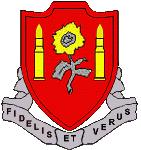


30 Years Later:
A Vietnam War
Mystery

by
Dan Fisher
"During the first two weeks of January 1969,
activity was light in Kontum Province
as the 6th Battalion 29th Field Artillery
continued its operations in the Dak To
area. On 21 January 1969, 1st Brigade,
4th Infantry Division terminated operations
in that area and established a new Brigade
Forward Command Post at FSB McNerney.
Contact was very light and sporadic throughout
the Brigade AO during the early part of
February, however the maneuver elements
found numerous huts, fortified positions,
weapons, rice and ordnance storage areas.
Artillery activity during this period consisted
mainly of firing on intelligence targets and
firing Night Firing Programs based on target
data gathered by the maneuver elements.
Extensive aerial reconaissance missions were
conducted by the battalion S-2/S-3 elements
in order to pin-point selected enemy locations,
trail and bunker complexes, bivouac areas
and routes of movement. The information
gathered during these aerial reconnaissance
missions was used to prepare night firing
programs.
On 15 February 1969, the 1st Brigade received
the mission to move to the southwest Kontum
City and conduct offensive operations against
the 24th and 66th NVA regiments. Intelligence
reports indicated that these enemy elements
had been given the mission to attack Kontum
City and interdict Highway 14. In order to
facilitate command and control the 1st Brigade
and 6/29 Arty deployed a Tactical Command
Post to Plei Mrong. Contacts with enemy
elements throughout the operations were numerous,
but small. On 28 February 1969, 1st Brigade terminated
operations in the vicinty of Plei Mrong and
moved the Tactcal CP, maneuver elements,
and artillery to the vicinity of Polei Kleng and
subsequent deployment into the Plei Trap Valley area.
The 1st Brigade's mission at its new location
was to block and destroy NVA transportation
routes in the Plei Trap Valley. The 6th Battalion
29th Field Artillery, as the direct support battalion
to the 1st Brigade, moved its operations center,
with the Brigade TOC, from Plei Mrong to
Polei Kleng to facilitate control of the operation.
The operation began on 1 March 1969 with
the CA of A/3/12 Infantry into LZ Swinger.
The LZ was considered of primary importance
for artillery when the 155mm howitzers of C/6/29
Artillery were emplaced at that location the majority
of the Brigade could be supported by their fires.
A/6/29 Artillery began its move from Polei Kleng
to FSB 20 of the same day. C/6/29 Artillery
moved to LZ Pause on 1 March 1969, and B/6/29
Artillery left Plei Mrong, spending the night at
FSB Mary Lou. All artillery moves were
completed by 3 March 1969.
Late in the afternoon 3 March, A/3/8 Infantry
made contact with an estimated enemy company.
Initial contact was heavy and the RTO in the
Artillery Forward Observer Party was killed
in the first few minutes. Elements of 3/8 Infantry
remained in contact with the NVA forces through
6 March. B/6/29 and C/6/29 Artillery fired a total
of 4478 rounds HE, 58 FC rounds, and 8 CS rounds,
primarily in support of the contacts and as preparations
for the combat assault of reinforcements.
At 0850 hours on 4 March, the air strip at
Polei Kleng received 14 rounds of 122mm
rocket fire, which destroyed the artillery resupply
Class V waiting on the helicopter pad to be
airlifted to the firebases.
The resulting fires and explosions not only
destroyed approximately 900 rounds of 105mm
HE ammunition but also the five remaining sorties
to complete the move of B/6/29 Artillery. During
the rocket attack the Executive Officer of B/6/29
Artillery was critically wounded."
This is all that is known about this action. Names
of the two casualties, were not specified, and this
is the mystery. Who were these two heros?
Research has shown that over 20 men of the
4th Infantry Division were killed in action in
Kontum Province on 3 March 1969. Of these,
the RTO killed on 3 Mar 69 appears to be
PFC Layne Michael Santos, Panel 30W, Line 30.
His specialty was 13A10, Artillery. The only
casualty with an artillery specialty killed that day.
The XO, critcally wounded on 4 Mar 69, was not
mentioned as having died. However, from research into
casualties on the very next day, he appears to be
1LT Ronald Leonard Warnett, Panel 30W, Line 50.
He died of wounds received, on 5 Mar 69.
His specialty was 1193, Artillery. Again, the only
casualty with an artillery specialty during the
period.
All of the names listed on Panel 30W, between Line 30 and Line 50 are 4th Infantry Division soldiers, for the most part.
Except for the two names noted above, all are infantry related specialties, which rule them out as the unidentified casualties mentioned in our unit history files.
Research has not yet positively confirmed these
men as the soldiers mentioned in the story. I
never knew either of these men, but 30 years
after their deaths, I find myself consumed with
confirming the identities of these two men. Hopefully, with time I can find some
closure in this story, and recognize our unknowns.
PFC Santos was confirmed as a casualty of 6-29 FA by Albert Jasquez, former A/3-8 Infantry.
1LT Warnett was confirmed by Tom LaCombe, former B/3-12 Infantry, AND Jim Lehmann, B/6-29 FA Medic.
Related Note: The Center For Military History has information which may be pertinet to this story, but it must be viewed
"in person" by the reseacher! Copies are not available by request, and personal resources preclude my going there
to investigate furthur. After action reports do not usually include casualty names, only units and numbers.
VNIT-588 Company A, 3d Battalion, 8th Infantry
Combat after action report, ambush and attack by NVA, 3-4 March 1969.
Account by a survivor when his 4th Infantry Division unit encountered overwhelming enemy force.
Dan Fisher, Master Sergeant, Retired
email at msgfisher@global2000.net